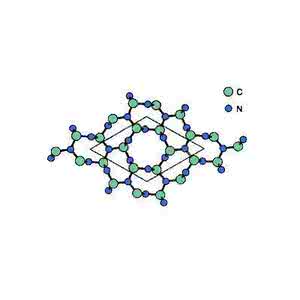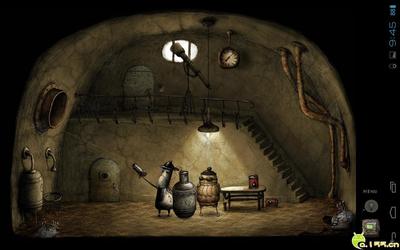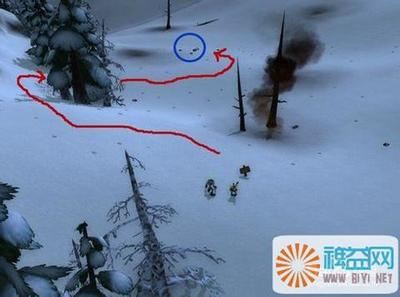PCCP
Published on 16 July 2014. Downloaded by Sichuan University on 08/06/2015 09:33:14.
Citethis:Phys.Chem.Chem.Phys.,2014,16,17627
Preparationofvisiblelight-driveng-C3N4@ZnOhybridphotocatalystviamechanochemistry?
JianweiZhou,abMoZhangbandYongfaZhu*b
C3N4@ZnOhybridmaterialswithvisiblelightphotocatalyticperformancehavebeenpreparedbyfacilemechanicalmilling.Thedispersionofconjugatedmoleculeg-C3N4onthesurfaceofZnOimprovedduringmechanicalprocess,andthemultilayerhybridstructureofg-C3N4@ZnOmaterialswithremarkablevisiblelightphotocatalyticactivitywasformedbyballmilling.Thephotocatalyticactivityandphotocurrentintensityofg-C3N4@ZnOundervisiblelightirradiationwas3.0and2.0timeshigherthanthoseofpureC3N4,respectively.Thegreatenhancementofvisiblelightresponseoriginatesfromthe
Received12thMay2014,Accepted2ndJuly2014DOI:10.1039/c4cp02061h
www.rsc.org/pccp
increaseofseparationandimmigratione?ciencyofphotogeneratedelectron–holepairs.Furthermore,asynergisticphotocatalysismechanismbetweenZnOandg-C3N4wasproposed.TheenhancedvisiblelightphotocatalyticpropertiesoriginatefromtheinjectionofexcitedelectronsfromtheLUMOofC3N4totheCBofZnO.However,thephotocatalyticactivityofthephotocatalystismuchlowerthanthatofZnOunderUVlight,whichiscausedbythelatticedefectofZnOformedduringmilling.
Introduction
Photocatalysistechnologyiswidelyusedforthedegradationoforganicpollutants.Thedevelopmentofnovelmaterials,whicharenon-toxic,lowincostandwithlong-termstabilityhasattractedgreatattention.Zincoxide(ZnO),animportant,inexpensivesemi-conductorwithawidebandgapof3.37eVandhighoxidationcapability,hasbeenproventoexhibithigherphotocatalyticactivitythanTiO2insomeconditions.1–4However,thephotocorrosionofZnOmaterialswasfoundtobesevereduringthereactionbytheactionofthephotogeneratedholes,whichmayaffectthestabilityandphotocatalyticactivityofZnO.5–10Inaddition,itsapplicationisalsolimitedbythelowquantumefficiencyandincompletevisiblelightharvesting.Therehavebeenmanyattemptstoenhanceitsphotocatalyticperformance,suchasdoping,11,12depositingmetals13–15andcouplingwithsemiconductors.16–20
Withconjugatedpsystem,graphiticcarbonnitride(g-C3N4)exhibitshighchemicalandthermalstability,aswellasversatilityinmechanical,electronicandopticalpropertiesduetotheoutstandingseparationandmigratione?ciencyofphotogeneratedelectron–holepairs.21–25IthasbeenreportedthatanorganicsurfacecoatingonZnOcouldenhancetheseparationofphotoinducedcarriersandprotectZnOfromphoto-corrosion.26,27Althoughtherehavebeen
InstituteofEnergyandFuel,XinxiangUniversity,Xinxiang,China453003.E-mail:jwchow@163.comb
DepartmentofChemistry,TsinghuaUniversity,Beijing,China100084.E-mail:zhuyf@tsinghua.edu.cn
?Electronicsupplementaryinformation(ESI)available:TEMimages,FT-IRspectra,XRDpatterns,Ramanspectraandfluorescenceemissionspectraofg-C3N4andg-C3N4@ZnOareavailableintheESI.SeeDOI:10.1039/c4cp02061h
a
manyattemptstopreparehybridphotocatalystsintheliquidphase,solidphasesynthesisisrarelyreported.28Herein,g-C3N4@ZnOhybridmaterialswithvisiblelightphotocatalyticperformancehavebeenpreparedbyfacilemechanicalmilling.Thevisiblelightphotocatalyticactivityissignificantlyimprovedbytheexpandedlightresponserangeandthephotocorrosioniseffectivelyinhibited.Themechanismoftheenhancementofthephotocatalyticactivityisalsodiscussed.
Experimental
Themorphologiesandstructuresofthesampleswereexaminedwithtransmissionelectronmicroscopy(TEM)byHitachiHT-7700TEMandJEM1010HRTEMoperatedatanacceleratingvoltageof100kVand200kV,respectively.UV-visdi?usereflectancespectroscopy(DRS)wascarriedoutonaHitachiU-3010UV-visspectrophotometer.BaSO4wasthereferencesample.TheBrunauer–Emmett–Teller(BET)surfaceareawasmeasuredbyASAP2010V5.02H.Thecrystallinityoftheas-preparedsamplewascharacterizedbyX-raydiffraction(XRD)onBrukerD8-advancediffractometerusingCu-Karadiation(l=1.5418?).Thephotocurrentsweremeasuredonanelectrochemicalsystem(CHI660B,China).Visiblelightwasobtainedfroma500Wxenonlamp(InstituteforElectricLightSources,Beijing)witha420nmcutofffilter.
Theg-C3N4wassynthesizedbydirectlyheatingmelamine.Inatypicalrun,5gmelaminepowderwasputintoanaluminacrucibleandheatedinamu?efurnaceat5301Cfor4hwithaheatingrateof51Cminà1.Aftercoolingtoroomtemperature,theproductwascollectedandgroundintopowder.Thepreparation
of
Thisjournalis?theOwnerSocieties2014Phys.Chem.Chem.Phys.,2014,16,17627--17633|17627
PaperPCCP
33:14.
C3N4@ZnOphotocatalystwascarriedoutinaballmiller(XQM-0.4,madeinChangsha,China).Theprocedureofpreparationisasfollows:ZnOpowderandagateballweremixedintheagateballmillingtankwitharatioof1:10,andthenacertainamountofC3N4wasadded.Afterbeingmilledforacertaintimeatdi?erentspeeds,thefinalsampleswereusedforcharacterizationandthedeterminationofphotocatalyticactivity.
Thephotocatalyticactivitieswereevaluatedbythedecompositionofmethyleneblue(MB).Visibleirradiationwasobtainedfroma500WXelamp(InstituteforElectricLightSources,Beijing)witha420nmcuto?filter,andtheaveragevisiblelightintensitywas35mWcmà2.TheUVirradiationwasobtainedfroma300WHglampwitha365nmcuto?filter.Theaverageintensitywas1.2mWcmà2.TheconcentrationofMBwasanalyzedbyrecordingtheabsorbanceofthecharacteristicbandat664nmusingaHitachiU-3010UV-visspectrophotometer.Toinvestigatethedegradationmechanism,radicaltrappingexperimentswereperformedundervisibleandUVlightirradiation.ThereactionconditionwasthephotodegradationofMBwiththeadditionof1mmolLà1hydroxylradicalscavenger(tBuOH)and1mmolLà1holescavenger(EDTA-2Na).
Toinvestigatethetransitionofphotogeneratedelectronsofg-C3N4,astandardthree-electrodecellwithaworkingelectrode(as-preparedphotocatalyst),aplatinumwireascounterelectrode,andastandardcalomelelectrode(SCE)asreferenceelectrodewereusedinthephotoelectricstudies.0.1MNa2SO4wasusedastheelectrolytesolution.PotentialsweregivenwithreferencetoSCE.Thephotoresponsesofthephotocatalystsatlightonando?weremeasuredat0.0V.Theworkingelectrodeswerepreparedasfollows:10mgoftheas-preparedphotocatalystwassuspendedin1mLethanoltoproduceaslurry,whichwasthendip-coatedontoa2cm?4cmindiumtinoxide(ITO)glasselectrode.Electrodeswereexposedtoairfor12htoeliminatewaterandsubsequentlycalcinedat1501Cfor5h.
Resultsanddiscussion
Formationofhybridcatalystsviamechanicalmilling
AsshowninTable1andTableS1(ESI?),thespecificsurfacearea(SBET),porevolume(Vp),andaverageporediameterofpureZnOincreaseafterballmilling,indicatingthesmallerparticlesizeofmilledZnO.ThevaluesofSBET,VPandaverageporediameterof3%-C3N4@ZnOdonotsignificantlychangewiththeincreaseofmillingspeed.However,thevaluesofSBET,VPandaverageporediameterofC3N4@ZnOdecreasewiththeincreaseofmillingspeed,whichmaybeattributedtothemechanicalandchemicalinteractionbetweenC3N4andZnOandthedispersionstateofC3N4.
Fig.1showstheporesizedistributioncurvesofsamplesdeterminedfromtheadsorptionbranchoftheisotherms.The
Table1
Thespecificsurfaceareaofthesampleatdi?erentmillingspeeds
ZnO
3%-C3N4@ZnOSamplesNomilling350rpm250rpm300rpm350rpmSBET(m2gà1)
10.3
13.0
12.3
12.1
12.5
17628|Phys.Chem.Chem.Phys.,2014,16,17627--17633Fig.1Theporesizedistributioncurvesof
samples.
hybridphotocatalystspreparedbyballmillingshowmoreapparentporedistributionthanpureZnO.Typicalnanoporesappearasbroadpeaksat5–40nmforhybridphotocatalyst,andthepeakcentersatabout10nm.Thechangesofporesizedistributionsofhybridcatalystpreparedatdifferentmillingspeedsarelessobvious,whichmaybeattributedtothemechanicalandchemicalinteractionbetweenC3N4andZnOandthedispersionstateofC3N4.
AscanbeseenfromtheHRTEMimages(Fig.2),thed-spacingofZnOis0.136nm,correspondingtothe(201)interplanarspacing.Thehigh-resolutionTEMimagesof3%-C3N4@ZnOshowthattheZnOparticlesaresurroundedbyC3N4layers,andtheoverallthicknessoftheC3N4shellisabout0.365nm,whichisidenticaltothethicknessofamonolayerofC3N4.Therefore,itcanbeconcludedthattheZnOparticlesaresurroundedbyC3N4monolayers.Asshownintheimagesof7%-C3N4@ZnO,thethicknessofC3N4layersaroundZnOparticlesisabout5nm,indicatingthemultilayerloadingofC3N4.
TheopticalpropertiesoftheC3N4@ZnOmaterialswereprobedwithUV-visdi?usereflectancespectroscopy,showninFig.3.
Fig.2High-resolutionTEMimagesof3%-C3N4@ZnO(a)and(b);7%-C3N4@ZnO(c)and(d).
Thisjournalis?theOwnerSocieties2014
Published on 16 July 2014. Downloaded by Sichuan University on 08/06/2015 09:
PCCPPaper
33:14.
Fig.3UV-visdi?usereflectancespectraofC3N4,ZnOandC3N4
@ZnO.
TheabsorptionedgeofC3N4@ZnOsamplesexpandstothevisiblelightregionduetothepresenceofC3N4ontheZnOsurface,indicatingthee?ectivesurfacehybridizationofZnObymechanicalmilling.TheabsorptionofvisiblelightoriginatesfromC3N4onthesurfaceoftheC3N4@ZnOmaterials.

AsshowninFig.4a,C3N4@ZnOmaterialsshowhigherphotocatalyticactivityundervisiblelightandthedegradationrateofMBincreaseswiththeincreasingamountofC3N4loading.Thedegradationrateincreasestoabout3timestothatofpureC3N4whentheamountofC3N4loadingwasincreasedfrom1%to7%.Theresultimpliesthattheseparationandmigratione?ciencyofphotogeneratedelectron–holepairswasimprovedbythesurfacehybridizationofC3N4,whichresultedintheenhancementofphotocatalyticactivity.ThephotocatalyticactivityundervisiblelightwasmainlygeneratedfromC3N4.Themigrationefficiencyofphotoinducedcarrierswasenhancedbytheconjugatedpbond.TheZnOmaterial,astheelectronacceptor,canfurtherincreasetheseparationefficiencyofphotogeneratedelectron–holepairs.
Fig.4bshowsthatthephotocurrentofhybridizedcatalystsundervisiblelightirradiationwasinorderof5%-C3N4@ZnO43%-C3N4@ZnO41%-C3N4@ZnO4C3N4,whichcoincideswiththatofthephotocatalyticactivityundervisiblelight.ThephotocurrentundervisiblelightmainlyoriginatedfromC3N4andwasdeterminedbytheseparatione?ciencyofphotogeneratedcarriersofC3N4materials.Therefore,thephotocurrentwasenhancedbytheincreasingamountofC3N4loadingandwaslargerthanthatofpureC3N4duetotheimprovedseparatione?ciencyofphotogeneratedcarriers,becauseofZnOactingastheelectronacceptor.Undervisiblelightirradiation,thephotocurrentof5%-C3N4@ZnOwasabout8timesashighasthatofC3N4.Thephotocurrentreflectstheseparatione?ciencyofphotogeneratedcarriers,hencethehybridizationofC3N4cane?ectivelyimprovetheseparatione?ciencyofphotogeneratedelectron–holepairs.AsshowninFig.5a,thephotocatalyticactivityofhybridizedcatalystsundervisiblelightwasenhancedwiththeincreasedmillingspeedandfixedmillingtime.Thereactionrateofthecatalystproducedbyamillingspeedof350rpmwasabout3timesashighaspureC3N4.Fig.5bshowsthatthephotocurrentundervisiblelightirradiationwasinorderofI350r4I300r4I250r4IC3N4.
Thisjournalis?theOwnerSocieties2014Fig.4VisiblelightphotocatalyticdegradationofMB(1?10à5molLà1)byg-C3N4@ZnOwithvariousweightcontentofC3N4(1%,3%,5%,and7%)under500WXelampwitha420nmcuto?filter(a);photocurrentresponsesofsamplesatdi?erentweightcontentofC3N4(1%,3%and5%),under500WXelampwitha420nmcuto?filter(b).
TheresultindicatesthatthephotocurrentofC3N4@ZnOmaterialswasincreasedremarkablybytheincreaseinmillingspeed.Thephotocurrentofhybridizedcatalystproducedbyamillingspeedof350rpmwasabout2timesashighaspureC3N4.TheenhancementofphotocurrentimpliedthattherewereinteractionsbetweenC3N4andZnO.Theseparatione?ciencyofphotogeneratedelectron–holepairwasincreasedbythemodificationofC3N4molecules,andtherebythephotocurrentresponsewassignificantlyimprovedaswell.
Thee?ectofballmillingtimeonthephotocatalyticactivityofg-C3N4@ZnOhybridphotocatalystisshowninFig.6.Theoptimummillingtimeis6h,andthereactionrateat6hisabout1.2timesasthatof10h.TheresultismainlycausedbytheincreasedactivitysitesandcrystallatticedistortionofZnOintheprocessofballmilling.
Thestabilityisofgreatsignificanceforphotocatalystsinpracticalapplications.Thephotoactivityof3%-C3N4@ZnOwasrecycle-testedundervisiblelight.ItisshowninFig.7thatthephotocatalystexhibitsstablephotocatalyticactivityfordecom-posingMBafterfourcycles.Thesmalldeclineintheactivityismainlyduetothelossofcatalystduringtheexperiment.Therefore,itshowsthattheMBdegradationabilitiesofg-C3N4@ZnOarenotdecreasedandtheirphotocatalyticactiv-itiesarestable,indicatingthestronghybridizatione?ectbetweenC3N4and
ZnO.
Phys.Chem.Chem.Phys.,2014,16,17627--17633|17629
Published on 16 July 2014. Downloaded by Sichuan University on 08/06/2015 09:
PaperPCCP
33:14.
Fig.5PhotocatalyticdegradationofMB(C0=1?10à5molLà1)byg-C3N4@ZnOwithvariousballmillingrate(r=250rpm,300rpmand350rpm)under500WXelampirradiationwitha420nmcuto?filter(a);transientphotocurrentresponsesofdi?erentballmillingrateundervisiblelight(500WXelampirradiationwitha420nmcuto?filter)
(b).
Fig.6E?ectsofballmillingtimeonthephotocatalyticactivitiesofg-C3N4@ZnOundervisible
light.MechanismofenhancedactivitybymechanicalmillingAsshowninFig.8,chargetransferonthesurfaceofelectrodeisdeterminedastheratedeterminingstepaccordingtothearcontheEISNyquistplotofallthesamples.ThearcradiusontheEISNyquistplotofallITO/C3N4@ZnOelectrodesissmallerthanthatoftheITO/C3N4electrodeundervisiblelight,whichmeansamoree?ectiveseparationofphotogeneratedelectron–holepairsandfasterinterfacialchargetransferhasoccurred.Theresultisconsistentwiththatofphotocurrent.
17630|Phys.Chem.Chem.Phys.,2014,16,17627--17633Fig.7Thestabilityofg-C3N4@ZnO(CMB=1?10à5molLà1,Cat.50mg/100mL,l4420
nm).
Fig.8Electrochemicalimpedancespectroscopy(EIS)NyquistplotofC3N4andg-C3N4@ZnO.
Theradicalstrappingexperimentsundervisiblelightwereemployedtoinvestigatethephotocatalysismechanismofg-C3N4@ZnOmaterials.Thewaterpollutantcanbedegradedbytheradicals(OH??,O2à??andholes)generatedduringthephotocatalyticreaction.Fig.9demonstratesthatphotocatalyticactivityofg-C3N4@ZnOremarkablyreducedbytheadditionoftert-butylalcoholasthehydroxylradicalscavenger,whichimpliesthatholesandO2à??radicalsarethemainoxidativespeciesinthereactionofg-C3N4
@ZnO.
Thisjournalis?theOwnerSocieties2014
Published on 16 July 2014. Downloaded by Sichuan University on 08/06/2015 09:
PCCPPaper
33:14.
thanthatofpureZnO.ThereducedphotocatalyticactivityunderUVwasmainlycausedbythegenerationofdefectsduringthemechanicalmillingprocess.
Fig.11bshowsthatthephotocurrentunderUVirradiationwasinorderofpureZnO41%-C3N4@ZnO43%-C3N4@ZnO45%-C3N4@ZnO47%-C3N4@ZnO4pureC3N4andpresentsasimilarchangetrendtothatofphotocatalyticactivityunderUVirradiation.ComparedwiththatofpureZnO,thephotocurrentofmilledpureZnOwasgreatlyreduced.Ononehand,thereductionofphotocurrentforhybridizedcatalystswasduetothedecreaseofUVabsorptionbythesurfacehybridizationofC3N4.Ontheotherhand,thedefectsonthesurfaceofmilledFig.9Thecaptureexperimentofactivespeciesof3%-C3N4@ZnOundervisible
light.
Onthebasisoftheaboveanalysis,itcanbeconcludedthatthephotocatalyticactivityoftheg-C3N4@ZnOhybridundervisiblelightmaybemainlyattributedtothechemicale?ectbetweenC3N4andZnO.ThepossiblemechanismisshowninFig.10.ItiswellknownthatZnOitselfcannotbeexcitedbyvisiblelight,whileC3N4canbeexcitedbyvisiblelightandphotogeneratedelectronsaregeneratedonLUMO.TheLUMOpositionofC3N4(à1.1eV)ishigherthanthatoftheconductionbond(CB)ofZnO(à0.2eV),sothephotogeneratedelectronsonLUMOofC3N4canbeeasilyinjectedintotheCBofZnOandsubsequentlytransfertothesurfaceoftheC3N4@ZnOhybridtoreactwithwaterandoxygen.Thisreactionyieldshydroxylandsuperoxideradicalsthatareabletooxidizethepollutantsbecauseoftheirhighoxidativecapacity,producingvisiblephotocatalyticactivity.
InfluenceofmechanicalmillingonUVphotoactivity
AsshowninFig.11a,thephotocatalyticactivityofg-C3N4@ZnOmaterialsunderUVirradiationdecreaseswiththeadditionofC3N4loading.ThephotocatalyticactivityofhybridizedcatalystswithalowcontentofC3N4isslightlyhigherbutismuchlower
Fig.10Schematicillustrationofelectron–holeseparationandtransportandphotocatalyticactivityoftheg-C3N4@ZnOphotocatalystundervisiblelight
irradiation.
Thisjournalis?theOwnerSocieties2014ZnObecametherecombinationcenterofphotogeneratedcarriers,whichdecreasedthephotocurrentaswell.
Fig.12ashowsthephotocatalyticactivityofcatalystsproducedbydi?erentmillingspeeds.Thecatalystproducedbyamillingspeedof350rpmexhibitsthemaximumactivityinhybridizedmaterials,buttheactivityisstilllowerthanthatofpureZnO.ToinvestigatethecauseofdecreasedactivityunderUVlight,pureZnOwasmilledusingthesamemethod.ThephotocatalyticactivityofmilledZnOwasnotablydecreased,whichmaybecausedbythestrainofthecrystalstructureandincreasingdefectsonthesurfaceofZnO.Thespeculationwasproved
by
Fig.11Photocatalyticactivityofg-C3N4@ZnOwithdi?erentcontentsofC3N4(1%,3%,5%and7%)underUVlight(300Whighpressuremercurylampwitha365nmcuto?filter)(a);photocurrentresponsesofdi?erentcontentofC3N4(1%,3%,5%and7%)underUVlight(15Wmercurylamp,254nminwavelength,ZnO(m)-milledZnO)(b).
Phys.Chem.Chem.Phys.,2014,16,17627--17633|17631
Published on 16 July 2014. Downloaded by Sichuan University on 08/06/2015 09:
PaperPCCP
33:14.
Fig.12E?ectsofballmillingrateonthephotocatalyticactivityunderUVlightirradiation(Under300WHglampwitha365nmcuto?filter)(a);transientphotocurrentresponsesofdi?erentballmillingrateunderUVlight(15Wmercurylamp,254nminwavelength)
(b).
photocurrentofcatalystsproducedbydi?erentmillingspeeds(Fig.12b).
TheUVactivityisdrasticallydecreasedviathemechano-chemicalmethodbetweenC3N4andZnOhybridization,com-paredwithpureZnOwithnoballmilling(Fig.13).Thereasonisthatwiththeincreaseinballmillingtime,thecrystallatticedistortionofZnOandmanydefectsmaybeproducedduringthemillingprocesstoresultinthedecreasedseparatione?ciencyofphotoexcitedchargecarrierscomparedwithpureZnO.
Fig.13Theinfluenceofdi?erentballmillingtimeonactivityunderUV
light.
17632|Phys.Chem.Chem.Phys.,2014,16,17627--17633Fig.14Electrochemicalimpedancespectroscopy(EIS)NyquistplotofZnO,C3N4andg-C3N4@ZnO.
AsshowninFig.14,chargetransferonthesurfaceofelectrodeisdeterminedastheratedeterminingstepaccordingtothearcontheEISNyquistplotofallthesamples.ThearcradiusontheEISNyquistplotofallITO/C3N4@ZnOelectrodesissmallerthanthatoftheITO/ZnOelectrodeunderUVlight,whichismainlycausedbythecarrierconcentration;thereactionrateincreasedandtheinterfacialresistancedecreasedunderUVlightirradiation.Theresultisconsistentwiththatofphotocurrent.
ThereducedphotocatalyticactivityunderUVofg-C3N4@ZnOcouldprobablybeattributedtotheformationofdefectsintheparticlesduringtheballmillingprocess.Duringtheprocessofballmilling,thecrystallatticeofZnOundergoessevereplasticdeformation,producingstressesandstrains.CrystallatticedistortionofZnOoccursandatthesametimemanydefectsinsideZnOparticlesareformedduringtheballmillingprocess.Thedefectsbecometherecombinationcenterofphoto-generatedcarriers,andtheUVphotocatalyticactivityisdecreasedbythem.
TheradicalstrappingexperimentsunderUVlightwereemployedtoinvestigatethephotocatalysismechanismofg-C3N4@ZnOmaterials.AsshowninFig.15,thephotocatalyticactivitywassomewhatreducedafteraddingtert-butylalcoholashydroxylradicalscavengerandwassignificantlyinhibitedafteraddingEDTA-2Naasholeradicalscavenger,indicatingthatholesandOH??radicalsarethemainoxidativespecieson
ZnO.
Thisjournalis?theOwnerSocieties2014
Published on 16 July 2014. Downloaded by Sichuan University on 08/06/2015 09:
PCCPPaper
5P.SpathisandI.Poulios,Corros.Sci.,1995,37,673–680.6A.vanDijken,A.H.Janssen,M.H.P.Smitsmans,D.VanmaekelberghandA.Meijerink,Chem.Mater.,1998,10,3513–3522.
7J.C.Wang,P.Liu,S.M.Wang,W.Han,X.X.WangandX.Z.Fu,J.Mol.Catal.A:Chem.,2007,273,21–25.
8P.E.deJongh,E.A.Meulenkamp,D.VanmaekelberghandJ.J.Kelly,J.Phys.Chem.B,2000,104,7686–7693.
9N.Daneshvar,D.SalariandA.R.Khataee,J.Photochem.Photobiol.,A,2004,162,317–322.
10X.Q.Qiu,L.P.Li,J.Zheng,J.J.Liu,X.F.SunandG.S.Li,
J.Phys.Chem.C,2008,112,12242–12248.
11X.Q.Qiu,G.S.Li,X.F.Sun,L.P.LiandX.Z.Fu,
33:14.
Fig.15ThecaptureexperimentofactivespeciesofZnOunderUVlight.
Conclusions
g-C3N4@ZnOhybridsvisiblelight-drivenphotocatalystshavebeenpreparedviamechanicalmilling.Thehybridphotocata-lystsclearlyshowedsuperiorphotocatalyticstabilityforthephotodegradationofmethyleneblue.Thevisiblelightphoto-catalyticactivityofg-C3N4@ZnOwas3.0timesasthatofpureC3N4sampleduetothestronginteractionbetweenC3N4andZnO.Thesuperiorphotocatalyticactivityofthehybridphoto-catalystmainlyoriginatesfromthetransitionofphoto-generatedelectronsonLUMOofC3N4andtheCBofZnO.Thissimplemechanicalmillingmethodcouldbeusedasauniversalpathwaytoimprovetheactivityofphotocatalystandappliedinenvironmentalremediation.
Acknowledgements
ThisworkwaspartlysupportedbyNationalBasicResearchProgramofChina(973Program)(2013CB632403),NationalHighTechnologyResearchandDevelopmentProgramofChina(2012AA062701)andChineseNationalScienceFoundation(20925725and21373121)
Notesandreferences
1A.A.Khodja,T.Sehili,J.F.PilichowskiandP.Boule,J.Photochem.Photobiol.,A,2001,141,231–239.
2B.Q.CaoandW.P.Cai,J.Phys.Chem.C,2008,112,680–685.
3Y.M.Cristina,J.Rodrouez,J.Freer,N.Dura
′nandH.Mansilla,Chemosphere,2000,41,1193–1197.
4E.A.Meulenkamp,J.Phys.Chem.B,1998,102,7764–7769.
Thisjournalis?theOwnerSocieties2014Nanotechnology,2008,19,5703–5708.
12J.Bandara,K.TennakoneandP.P.B.Jayatilaka,Chemo-sphere,2002,49,439–445.
13L.Q.Jing,B.Q.Wang,B.F.Xin,S.D.Li,K.Y.Shi,W.M.Cai
andH.G.Fu,J.SolidStateChem.,2004,177,4221–4227.14A.Stroyuk,V.V.ShvalaginandS.Y.Kuchmii,Theor.Exp.
Chem.,2004,40,98–104.
15M.L.Zhang,T.C.An,X.H.Hu,C.Wang,G.Y.Shengand
J.M.Fu,Appl.Catal.,A,2004,260,215–222.
16R.S.Mane,W.J.Lee,H.M.PathanandS.H.Han,J.Phys.
Chem.B,2005,109,24254–24259.
17X.G.Chen,Y.Q.He,Q.Zhang,L.J.Li,D.H.HuandT.Yin,
J.Mater.Sci.,2010,45,953–960.
18R.Comparelli,E.Fanizza,M.L.Curri,P.D.Cozzoli,
G.MascoloandA.Agostiano,Appl.Catal.,A,2005,60,1–11.19Y.Wang,R.Shi,J.LinandY.Zhu,EnergyEnviron.Sci.,2011,
4,2922–2929.
20G.Yu,J.Gao,J.C.Hummelen,F.WudlandA.J.Heeger,
Science,1995,270,1789–1791.
21J.M.Hu,W.F.Cheng,S.P.Huang,D.S.WuandZ.Xie,
Appl.Phys.Lett.,2006,89,261117–261119.
22Y.Wang,X.Bai,C.Pan,J.HeandY.Zhu,J.Mater.Chem.,
2012,22,11568–11573.
23C.Pan,J.Xu,Y.Wang,D.LiandY.Zhu,Adv.Funct.Mater.,
2012,22,1518–1524.
24X.Bai,L.Wang,R.ZongandY.Zhu,J.Phys.Chem.C,2013,
117,9952–9961.
25H.B.Fu,T.G.Xu,S.B.ZhuandY.F.Zhu,Environ.Sci.
Technol.,2008,42,8064–8069.
26H.Zhang,R.L.ZongandY.F.Zhu,J.Phys.Chem.C,2009,
113,4605–4611.
27L.W.Zhang,H.Y.Cheng,R.L.ZongandY.F.Zhu,J.Phys.
Chem.C,2009,113,2368–2374.
28S.C.Yan,S.B.Lv,Z.S.LiandZ.G.Zou,DaltonTrans.,2010,
39,
1488–1491.
Phys.Chem.Chem.Phys.,2014,16,17627--17633|17633
Published on 16 July 2014. Downloaded by Sichuan University on 08/06/2015 09:
百度搜索“爱华网”,专业资料,生活学习,尽在爱华网
 爱华网
爱华网


